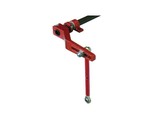In a front-wheel drive car, all of the steering and power comes from the front wheels. The usual result is that the typical front-wheel car has a tendency to understeer. If the car is going to fast, or turned too abruptly when entering a corner, the car will push ahead in a straight line, rather than turning to follow the direction of the front wheels. Understeer is what occurs when a car steers less than (under) the amount commanded by the driver.
Understeer is a good thing for the average driver turning the average corner, since the car is less likely to swerve or skid, should the driver turn the steering wheel too far or too fast. In fact, even most modern rear-wheel cars are engineered to have a little understeer.
However, since we want to get around the corners faster than the average driver, and we’re willing to invest some time and practice in learning to drive the car better, reducing that understeer seems like a good idea. Though it seems counter intuitive we can reduce the understeer on the front wheels by altering one component of the rear suspension, the rear “sway bar.”
The MINI Cooper S has a sway bar on the rear for just this purpose, to help tune the suspension. The rear sway bar keeps the rear wheels of the car more level as the car goes into corners. A sway bar—or as it is generally and more accurately referred to, an “anti-sway bar”—works by connecting the wheels on either side of the car to one another and to the chassis.
As the inside corner of the chassis begins to move up when the car rolls toward the outside of the turn, the sway bar transmits some of this motion to the outside rear corner. The net result is that the inside corner doesn’t go up as much, and the outside corner goes up more, than they would without the sway bar.
Again, think of the car as if it is balanced on a pin at its center. If we can keep the back end flatter on the turns so that the inside rear corner of the chassis doesn’t rise, less pressure is put on the outside front wheel and the car doesn’t push, or understeer as much. Instead, the rear end of the car comes around more easily. Instead of resisting the turn, the car will follow the line of the turn more easily.
However, the stock sway bar installed on the MINI represents a compromise between reducing chassis roll and affecting ride comfort in favor of ride comfort. It is also fixed in place, so it doesn’t allow any choice of response regardless of what you’ll be using your MINI for.
To improve on that situation, aftermarket suppliers have developed a stiffer rear sway bar that also has an adjustment range from harder to softer responsiveness. The original sway bar is 13mm thick, while one typical aftermarket sway bar is 16mm thick. The thicker bar is capable of transmitting more force from one side of the car to the other, helping the car stay level and balanced on tighter turns.
This upgraded sway bar also has sliding attachment points at each end, so that the range of movement can be changed. With these adjustments, you can leave it on the soft setting for daily use, so that the car sways a little bit more, but doesn’t ride quite so roughly. When you’re getting the car ready for a track day or an autocross competition, you just release the tension bolts and slide the attachments to the hard setting to increase the car’s cornering capability.
The typical dual-use adjustable rear sway bar kit, including the sway bar, drop link arms, bushings, and fasteners is available for about $250. The installation is straightforward, but does require putting the car on jack stands, and then removing the old bar and getting the new bar to slide in around the rear suspension components and wiring harness, so you may wish to have an experienced professional shop do the job for you.
Even heavier rear anti-sway bars are available for drivers who expect to spend a greater proportion of their time on the track or do serious autocross competition, might consider one of the heavier rear anti-sway bar that are also available. Some of these heavier bars have a more positive multi-position adjustment mechanism. The heavier rear bar is generally used in conjunction with the substitution of a heavier front roll bar in order to keep the car balanced from front to rear as well as side to side.
More Information about Getting the Maximum from your MINI can be found in Book45








